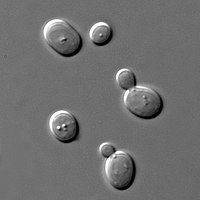
High pullulan biosynthesis from high concentration of glucose by a hyperosmotic resistant, yeast-like fungal strain isolated from a natural comb-honey.
Sign Up to like & getrecommendations! Published in 2019 at "Food chemistry"
DOI: 10.1016/j.foodchem.2019.01.206
Abstract: A novel, yeast-like fungal strain, Aureobasidium melanogenum TN3-1, that was isolated from natural honey can actively transform 140.0 g/L of glucose into 110.29 ± 2.17 g/L of pullulan during fermentation, whereas A. melanogenum P16 and TN1-2 converted 140.0 g/L of… read more here.
Keywords: yeast like; fungal strain; isolated natural; like fungal ... See more keywords

PSX-B-14 Properties of Kluyveromyces marxianus strains isolated from natural biotopes
Sign Up to like & getrecommendations! Published in 2021 at "Journal of Animal Science"
DOI: 10.1093/jas/skab235.600
Abstract: Kluyveromyces marxianus yeast is often isolated from dairy products and used as probiotic agents in food. As a producer-yeast they must be genetically stable, have simple nutrient requirements, be effective in hostile conditions, grow on… read more here.
Keywords: natural biotopes; strains showed; kluyveromyces marxianus; marxianus strains ... See more keywords

Specibacter cremeus gen. nov., sp. nov., a new member of the family Micrococcaceae isolated from a natural cave.
Sign Up to like & getrecommendations! Published in 2019 at "International journal of systematic and evolutionary microbiology"
DOI: 10.1099/ijsem.0.003392
Abstract: A Gram-reaction-positive, non-spore-forming, rod-shaped bacterium, strain C1-50T, was isolated from a natural cave in Jeju, Republic of Korea by using the serial dilution plating method. Results of phylogenetic analysis using 16S rRNA gene sequences showed… read more here.
Keywords: specibacter cremeus; natural cave; family; strain 50t ... See more keywords

The Influence of Temperature and Nitrogen Source on Cellulolytic Potential of Microbiota Isolated from Natural Environment
Sign Up to like & getrecommendations! Published in 2019 at "Polish Journal of Microbiology"
DOI: 10.21307/pjm-2019-012
Abstract: Abstract Bacteria from the genus Bacillus are a rich source of commercial enzymes, including amylases, proteases, cellulases, glucose isomerase, and pullulanase. Cellulases account for 15% of the global market of industrial enzymes; thus, new microorganisms… read more here.
Keywords: temperature; source; cellulolytic potential; natural environment ... See more keywords